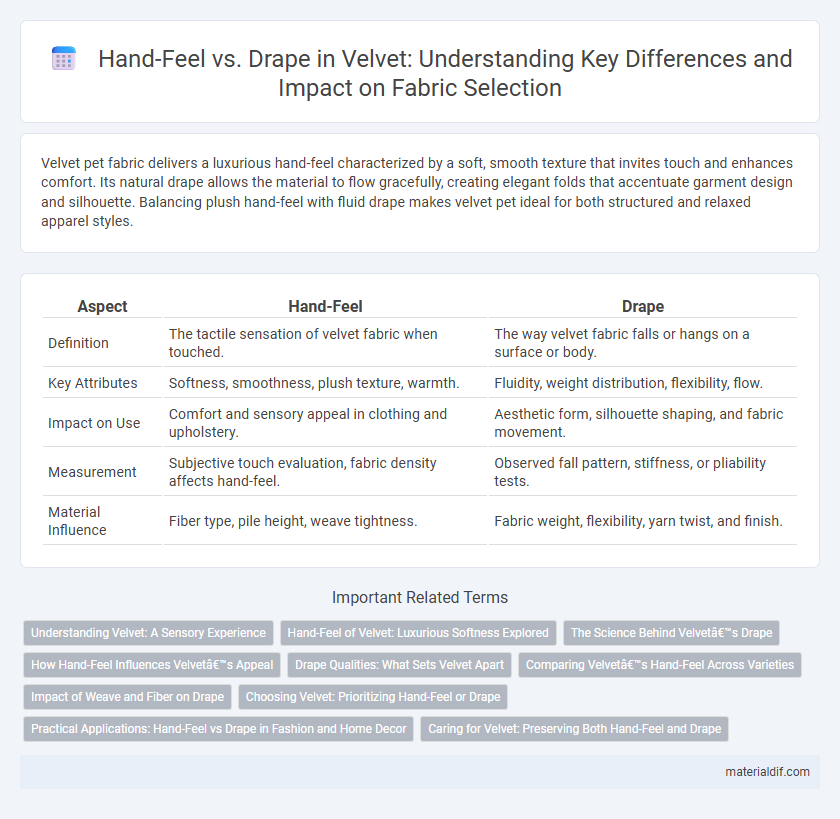Velvet pet fabric delivers a luxurious hand-feel characterized by a soft, smooth texture that invites touch and enhances comfort. Its natural drape allows the material to flow gracefully, creating elegant folds that accentuate garment design and silhouette. Balancing plush hand-feel with fluid drape makes velvet pet ideal for both structured and relaxed apparel styles.
Table of Comparison
| Aspect | Hand-Feel | Drape |
|---|---|---|
| Definition | The tactile sensation of velvet fabric when touched. | The way velvet fabric falls or hangs on a surface or body. |
| Key Attributes | Softness, smoothness, plush texture, warmth. | Fluidity, weight distribution, flexibility, flow. |
| Impact on Use | Comfort and sensory appeal in clothing and upholstery. | Aesthetic form, silhouette shaping, and fabric movement. |
| Measurement | Subjective touch evaluation, fabric density affects hand-feel. | Observed fall pattern, stiffness, or pliability tests. |
| Material Influence | Fiber type, pile height, weave tightness. | Fabric weight, flexibility, yarn twist, and finish. |
Understanding Velvet: A Sensory Experience
Velvet's luxurious hand-feel is characterized by its soft, plush texture that provides a tactile richness, making it highly desirable in fashion and upholstery. The drape of velvet differs significantly from other fabrics due to its weight and pile, allowing it to hang smoothly with a fluid, elegant flow that enhances garment silhouette and interior design aesthetics. Understanding these sensory qualities is essential for selecting the right velvet for specific applications, balancing comfort with visual appeal.
Hand-Feel of Velvet: Luxurious Softness Explored
Velvet's hand-feel is defined by its plush, smooth texture that delivers a rich and luxurious softness, making it highly desirable for upholstery and fashion. The dense pile of velvet fibers creates a tactile experience that is both gentle and inviting to touch, enhancing comfort and elegance. This softness distinguishes velvet from other fabrics, emphasizing its premium quality and sensory appeal.
The Science Behind Velvet’s Drape
Velvet's drape is influenced by the fabric's pile density, fiber type, and weave structure, which collectively determine how it contours and flows over surfaces. The hand-feel of velvet, shaped by the softness and thickness of its fibers, affects the tactile sensation, whereas drape is connected to the fabric's weight and flexibility, allowing it to fall smoothly and create elegant folds. Research shows that synthetic blends in velvet enhance drape by increasing fluidity, while natural fibers like silk provide a luxurious hand-feel with moderate drape performance.
How Hand-Feel Influences Velvet’s Appeal
Velvet's hand-feel, characterized by its soft and plush texture, significantly enhances its luxurious appeal and tactile comfort. The smooth, dense pile of velvet creates a rich, inviting sensation that influences consumer preference and perception of quality. This tactile allure often outweighs drape considerations, positioning hand-feel as a crucial factor in velvet's desirability in fashion and upholstery.
Drape Qualities: What Sets Velvet Apart
Velvet's drape qualities are defined by its dense pile and luxurious texture, which create a fluid and elegant fall unmatched by other fabrics. The fabric's weight and softness contribute to a smooth, graceful drape that enhances garment silhouette and interior decor. Unlike more rigid textiles, velvet molds to shapes while maintaining structure, making it a preferred choice for opulent upholstery and high-fashion garments.
Comparing Velvet’s Hand-Feel Across Varieties
Velvet's hand-feel varies significantly across its different varieties, with silk velvet offering a soft, smooth texture that feels luxurious against the skin, while cotton velvet provides a denser, more substantial hand-feel that conveys warmth and durability. Rayon velvet strikes a balance with a plush, supple hand-feel, making it versatile for both apparel and upholstery. Understanding these subtle differences helps in selecting the right velvet type for comfort, aesthetic appeal, and intended use.
Impact of Weave and Fiber on Drape
The drape of velvet is significantly influenced by the weave structure and fiber composition, with a tighter weave producing a stiffer drape and a looser weave allowing for more fluid movement. Natural fibers like silk offer a luxurious, soft hand-feel with enhanced drape flexibility, while synthetic fibers such as polyester provide durability but often result in a heavier, less pliable drape. Understanding the interplay between fiber type and weave density is essential for designers aiming to achieve the desired balance between hand-feel softness and elegant fabric drape in velvet textiles.
Choosing Velvet: Prioritizing Hand-Feel or Drape
Choosing velvet requires balancing hand-feel and drape to achieve the desired tactile and visual effect. Smooth, soft hand-feel velvet often enhances comfort in apparel, while velvet with superior drape contours gracefully, ideal for elegant gowns and upholstery. Prioritizing these qualities depends on the velvet's fiber content, weave, and pile density, directly influencing its texture and fluidity.
Practical Applications: Hand-Feel vs Drape in Fashion and Home Decor
Velvet's hand-feel offers a soft, plush texture ideal for garments requiring comfort and luxury, such as evening wear and accessories, while its drape influences garment silhouette and movement, crucial in dresses and curtains for smooth flow. In home decor, velvet's tactile richness enhances upholstery and cushions, providing a welcoming touch, whereas its drape affects the elegance of window treatments and throws. Understanding velvet's balance between hand-feel and drape allows designers to optimize both aesthetic appeal and functional comfort in fashion and interior design.
Caring for Velvet: Preserving Both Hand-Feel and Drape
Proper care for velvet fabric is essential to maintain its luxurious hand-feel and elegant drape; avoid excessive washing and opt for gentle hand cleaning or professional dry cleaning to preserve texture and shape. Storing velvet garments in a cool, dry place and using padded hangers helps prevent creases and crushing, which can alter the fabric's softness and flow. Regularly steaming velvet can refresh fibers without damaging the pile, ensuring the fabric retains its tactile richness and graceful movement over time.
Hand-Feel vs Drape Infographic

 materialdif.com
materialdif.com